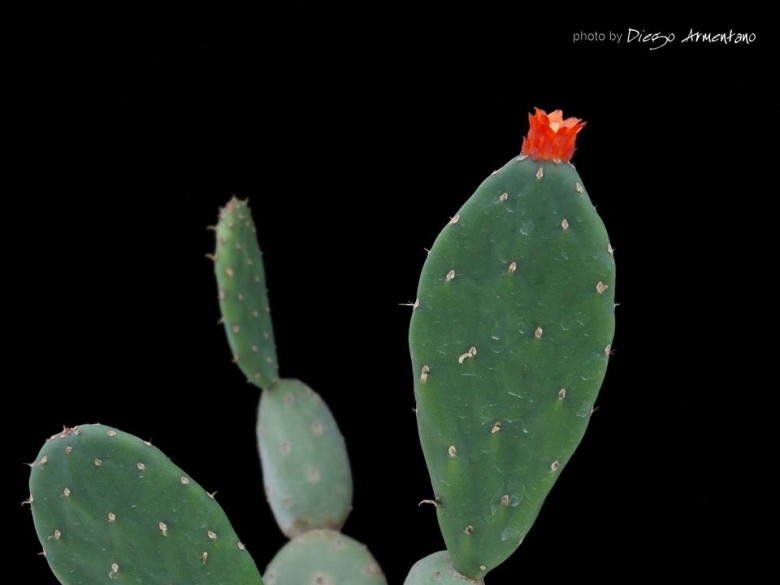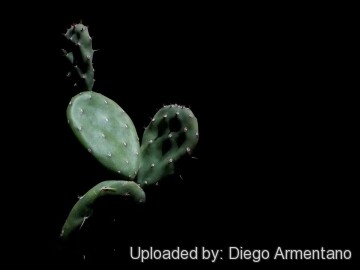Accepted Scientific Name: Opuntia quitensis
Dict. Hort. [Bois] 894 1898.

Opuntia johnsonii Photo by: Diego Armentano
It has pads reminiscent of Opuntia catingicola, but smaller, and produces, orange tubular flowers, which are all embedded in a flattened joint, replacing the pericarpel. These flowers, that don't seem quite open, come from the extremity of the pads, one per pad.
Origin and Habitat: Northern Peru-Ecuador frontier zone.
Synonyms:
See all synonyms of Opuntia quitensis
back
Accepted name in llifle Database:Opuntia quitensis F.A.C.WeberDict. Hort. [Bois] 894 1898.Synonymy: 5
back
Common Names include:
ENGLISH: Red Buttons, Red button opuntia, Red Buttons Opuntia
SPANISH (Español): pencho, tunilla
Description: Opuntia quitensisSN|32733]]SN|32733]] is often encountered as Opuntia johnsoniiSN|32733]]SN|32732]], named after Harry Johnson, owner of big garden in Fallbrook, California, USA. Opuntia johnsoniiSN|32732]]SN|32732]] is an invalid name (nom, inval. Art. 36.1) describing a local or morphological form of the widespread and variable Opuntia quitensis. It has pads reminiscent of Opuntia catingicola, but smaller, and produces, orange tubular flowers, which are all embedded in a flattened joint, replacing the pericarpel. These flowers, that don't seem quite open, come from the extremity of the pads, one per pad. However the distinguishing characteristics of Opuntia johnsoniiSN|32732]]SN|32732]], appear to fall within the natural variation of Opuntia quitensisSN|32732]]SN|32733]] and it should be synonymized with the latter. The plants are dioecious (there are male flowers and female flowers).
For more details see: Opuntia quitensisSN|32733]]SN|32733]]
Subspecies, varieties, forms and cultivars of plants belonging to the Opuntia quitensis group
 Opuntia johnsonii: has small pads with orange tubular flowers, which come from the extremity of the pads, one per pad. Distribution: Northern Peru-Ecuador frontier zone.
Opuntia johnsonii: has small pads with orange tubular flowers, which come from the extremity of the pads, one per pad. Distribution: Northern Peru-Ecuador frontier zone. - Opuntia quitensis F.A.C.Weber
Bibliography: Major references and further lectures
1) Curt Backeberg “Die Cactaceae: Handbuch der Kakteenkunde”, Volume 6 G. Fischer, 1962
2) Urs Eggli, Nigel P. Taylor “List of Cactaceae Names from Repertorium Plantarum Succulentarum (1950-1990)” Royal Botanic Gardens, 1991
3) Werner Rauh “Kakteen an ihren Standorten.: Unter besonderer Berücksichtigung ihrer Morphologie und Systematik” Parey, 1979
4) Philippe Faucon, “Red Buttons Opuntia Scientific Name: Opuntia quitensis Weber” Desert Tropicals com retrieved 26 March 2016 from <http://www.desert-tropicals.com/Plants/Cactaceae/Opuntia_macbridei.html>
 Opuntia johnsonii Photo by: Diego Armentano
Opuntia johnsonii Photo by: Diego ArmentanoSend a photo of this plant.The gallery now contains thousands of pictures, however it is possible to do even more. We are, of course, seeking photos of species not yet shown in the gallery but not only that, we are also looking for better pictures than those already present.
Read More... Cultivation and Propagation: Opuntia johnsoniiSN|32732]]SN|32732]] is a low maintenance plant that tolerate considerable neglect and will naturalize. Easy to cultivate outdoor in warm dry climates.
Growth rate: it is a relatively fast growing species that can form large clumps just in a few year.
Soils: It grows well in sandy or gravely, well-drained soils. May be grown in clay soils as long as drainage is good and soils do not remain wet, it is very adaptable both in acid, neutral and basic (alkaline) soils, but prefers a pH in the range 6 to 7,5. For pot culture it needs regular cacti soil with little organic matter (peat, humus).
Repotting: Since they are big-sized plants, they need plenty of space for their roots. Repotting should be done every other year, or when the plant has outgrown its pot. Use pot with good drainage.
Watering Needs: Must be kept fairly dry in winter but likes a reasonable supply of water in the growing season, but do not overwater and allow to dry fully before watering again, tolerate dry condition but suffer if exposed to prolonged and severe drought. A position at the base of a south-facing wall or somewhere that can be protected from winter rain is best for this plant, but is however resistant to moisture and rain. Care must be taken with watering as they tends to become swollen and untidy in growth habit if given too much water and shade.
Fertilization: During the growing season enrich the soil using a fertilizer rich in potassium and phosphorous, but poor in nitrogen, because this chemical element doesn’t help the development of succulent plants, making them too soft and full of water.
Sun Exposure: Full sun (only), in semi shaded position wont produce many flowers.
Hardiness: Reputedly sensitive to frost, but less so if kept on the dry side prior to, and during, cold weather (hardy to -5° C or less for short periods, depending on clone). Outdoors this plant is very adaptable, as long as you avoid excessive humidity in the winter months (in good drained soils).
Garden uses: Excellent as landscape or patio plant. It is suitable for “desert” or “Mediterranean” gardens, in association with other xerophytes. Where the open air cultivation is not possible due to the climate, it is to be cultivated in pot in order to shelter it in winter.
Pests & diseases: It may be attractive to a variety of insects, but plants in good condition should be nearly pest-free, particularly if they are grown with good exposure and ventilation.
Warning: Opuntias bear spines and glochids (stiff bristles on the surface of the cladode) that can be very irritating to the skin.
Propagation: Propagated almost exclusively by cuttings of leaf pads at any time in the growing season. It may also be propagated by seeds. Seeds germinate in 7-14 days at 21-27° C in spring, remove the glass cover gradually as the plants develops and keep ventilated, no full sun for young plants! The seedlings should not be disturbed until they are well rooted, after which they can be planted separately in small pots.












